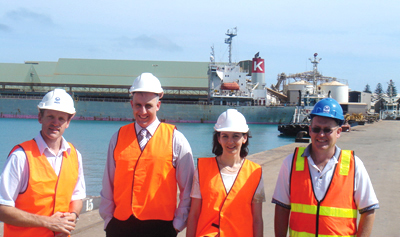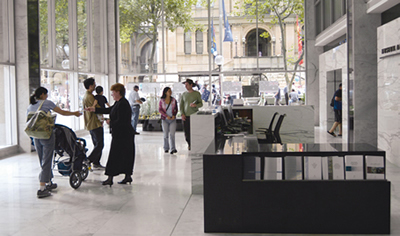Reserve Bank of Australia Annual Report – 2007 The Reserve Bank in the Community
Activities of the Regional Offices
In addition to its head office located in New South Wales, the Reserve Bank has offices in Victoria, Queensland, South Australia and Western Australia.[1] This network of Regional Offices is an important component of the Reserve Bank's presence in the community, fostering greater communication with members of the public, business, government and academia in their respective States and facilitating events involving the Reserve Bank in their local area.
As part of the Reserve Bank's efforts to keep the public informed of its evolving views on the economy, Regional Office staff regularly give presentations on economic developments to business groups, community organisations and educational institutions, in both State capitals and regional centres. In addition, senior staff from Economic Group visit the Regional Offices each quarter, following the release of the Statement on Monetary Policy, to brief groups of liaison contacts on the main themes. There were 56 such presentations and briefings in 2006/07.
In addition to their representational role, the Regional Offices are a key component of the Reserve Bank's business liaison program. Since 2001, the Bank has systematically built relationships across a broad cross-section of the business community, with a view to gaining first-hand insights into conditions in different industries and regions within the national economy. The staff involved in the regional liaison program have built up a pool of over 1,500 regular contacts around the country, visiting about 100 of them each month. The information obtained is reported in detail to Head Office and incorporated into the material prepared for monthly Board meetings and in the quarterly Statement on Monetary Policy. In this way, information obtained from liaison is used as a complement to standard sources, such as data from the Australian Bureau of Statistics and business surveys, in forming the Reserve Bank's assessment of the economy.

Museum of Australian Currency Notes
The Museum, which opened in March 2005, exhibits the story of Australia's currency notes against the background of the nation's broader history. After an introductory stage on developments before Federation, which includes Australia's first gold coins, visitors can review the various series of notes produced since the first Australian notes in 1913–1915. The final stage in the Museum focuses on Australia's polymer banknotes, including information on their design, security, recycling and other features. As well as viewing the original notes, visitors can learn about the men and women represented on the notes over the years, the artwork used in their design and some of the key historical episodes in Australian history through the Museum's displays of archival film, photographs and documents.
About 8,650 people visited the Museum in 2006/07. The museum has been particularly popular with school groups, many of which receive a short presentation on the Reserve Bank or, in the case of senior students, a talk on the Australian economy. Most of the information in the Museum is on the Reserve Bank's website, where visitors can also take a virtual tour of the Museum. Around 160,000 people visited the Museum online in the past year, over half from other countries.

Financial Assistance for Research and Education
The Reserve Bank sponsors a range of research and related activities, such as conferences and workshops, that are associated with its primary responsibilities. Several universities and think-tanks were sponsored by the Reserve Bank in 2006/07, with their activities focusing on areas including macroeconomics, econometrics and financial markets. Sponsorships such as these can be on a one-off basis or ongoing.
For many years the Bank has contributed towards the cost of a monthly survey of inflation expectations, undertaken by the Melbourne Institute of Applied Economic and Social Research at the University of Melbourne, and a quarterly survey of union inflation and wage expectations, undertaken by the Workplace Research Centre at the University of Sydney.
The Reserve Bank continued its support for the International Journal of Central Banking, the primary objectives of which are to disseminate first-class policy-relevant and applied research on central banking and to promote communication among researchers both inside and outside central banks. The Bank continued its support of the International Accounting Standards Committee Foundation following completion in 2005 of the initial five-year support plan, and also its long-standing practice of contributing to the Group of Thirty in support of its program of research and publications in the area of international finance.
Financial assistance to Australian universities each year includes contributions towards the costs of their organising conferences in economics and closely related fields. In 2006/07, these conferences included the annual Conference for PhD Students in Economics and Business, held at the Australian National University; the Economic Society of Australia's 35th Conference of Economists, held at Curtin University; the 12th Melbourne Money and Finance Conference, held at the University of Melbourne; the 12th Australasian Macroeconomic Workshop, held at La Trobe University; the Australasian Meeting of the Econometric Society, held at the University of Queensland; the University of New South Wales' 19th Australasian Finance and Banking Conference; and the Financial Integrity Research Network Doctoral Tutorial, held at the University of Technology Sydney. The Bank was also a sponsor of the Melbourne Centre for Financial Studies' inaugural International Distinguished Lecture, delivered by Mervyn King, Governor of the Bank of England.
In order better to engage and support students of economics, the Reserve Bank is sponsoring an essay competition for undergraduate students across Australia, to be organised jointly with the University of New South Wales Economics Society. Entrants are required to submit a 2,000-word essay analysing the consequences of an ageing population for Australia's future economic growth and commenting on its implications for economic policy. The winners of the competition will receive a prize and be recognised by a presentation at the Reserve Bank.
In conjunction with APRA, the Bank has continued sponsorship of the Brian Gray Scholarship Program, initiated in 2002 in memory of a former senior officer of the Reserve Bank and APRA; three scholarships were awarded under this program in 2007, two for honours year studies and the other for a Bachelor of Science degree majoring in Statistics, Finance and Mathematics, all at the Australian National University.
The Reserve Bank also provides annual sponsorship for one officer from the Bank of Papua New Guinea to study at post-graduate level at an Australian university. The current scholarship holder is undertaking a Master of Business (Applied Finance) degree at the Queensland University of Technology.
Charitable Activities
During the year, the Reserve Bank made its fifth annual contribution of $50,000 to the Financial Markets Foundation for Children, of which the Governor is Chairman; along with several other Australian financial institutions, the Bank is committed to support the Foundation to this extent for a further five years. In July 2007, in its second public event to raise funds, the Governor addressed the Anika Foundation, which was established in 2005 to raise funds to support research into adolescent depression and suicide.
Reserve Bank staff interact with the community in a number of volunteering capacities, including, in the past year, the Cancer Council's Daffodil Day fundraiser, the Jeans for Genes Day annual fundraiser for the Children's Medical Research Institute and the Christmas food collection for the Salvation Army's Streetlevel Mission. Staff also run a Benevolent Fund, funded by regular salary deductions and special fund raisings, which makes donations to the charities it supports.
Footnote
The Victorian Office covers Tasmania, the South Australian Office covers the Northern Territory and staff in Head Office cover the Australian Capital Territory. [1]